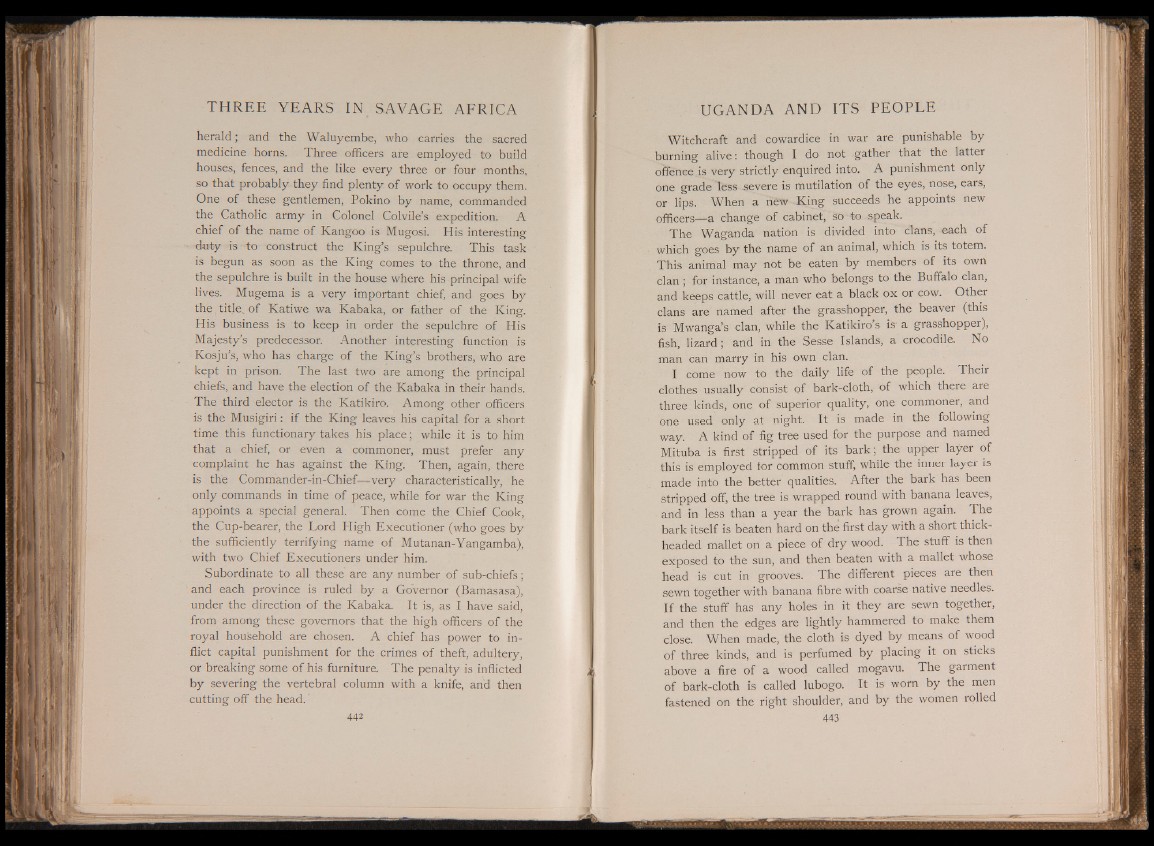
herald; and the Waluyembe, who carries the sacred
medicine horns. Three officers are employed to build
houses, fences, and the like every three or four months,
so that probably they find plenty of work to occupy them.
One of these gentlemen, Pokino by name, commanded
the Catholic army in Colonel Colvile’s expedition. A
chief of the name of Kangoo is Mugosi. His interesting
duty is to construct the King’s sepulchre. This task
is begun as soon as the King comes to the throne, and
the sepulchre is built in the house where his principal wife
lives. Mugema is a very important chief, and goes by
the title, of Katiwe wa Kabaka,' or father of the Kineor.
His business is to keep in order the sepulchre of His
Majesty’s predecessor. Another interesting function is
Kosju’s, who has charge of the King’s brothers, who are
kept in prison. The last two are among the principal
chiefs, and have the election of the Kabaka in their hands.
The third elector is the Katikiro. Among other officers
is the Musigiri: if the King leaves his capital for a short
time this functionary takes his place; while it is to him
that a chief, or even a commoner, must prefer any
complaint he has against the King. Then, again, there
is the Commander-in-Chief—very characteristically, he
only commands in time of peace, while for war the King
appoints a special general. Then come the Chief Cook,
the Cup-bearer, the Lord High Executioner (who goes by
the sufficiently terrifying name of Mutanan-Yangamba),
with two Chief Executioners under him.
Subordinate to all these are any number of sub-chiefs;
and each province is ruled by a Governor (Bamasasa),
under the direction of the Kabaka. It is, as I have said,
from among these governors that the high officers of the
royal household are chosen. A chief has power to inflict
capital punishment for the crimes of theft, adultery,
or breaking some of his furniture. The penalty is inflicted
by severing the vertebral column with a knife, and then
cutting off the head.'
’Witchcraft and cowardice in war are punishable by
burning alive: though I do not gather that the latter
offence is very strictly enquired into. A punishment only
one grade less .severe is mutilation of the eyes, nose, ears,
or lips. When a new King succeeds he appoints new
officers—a change of cabinet, go to speak.
The Waganda nation is divided into clans, each of
which goes by the name of an animal, which is its totem.
This animal may not be eaten by members of its own
clan ; for instance, a man who belongs to the Buffalo clan,
and keeps cattle, will never eat a black ox or cow. Other
clans are named after the grasshopper, the beaver (this
is Mwanga’s clan, while the Katikiro s is a grasshopper),
fish, lizard; and in the Sesse Islands, a crocodile. No
man can marry in his own clan.
I come now to the daily life of the people. Their
clothes usually consist of bark-cloth, of which there are
three kinds, one of superior quality, one commoner, and
one used only at night. It is made in the following
way. A kind of fig tree used for the purpose and named
Mituba is first stripped of its bark; the upper layer of
this is employed for common stuff, while the inner layer is
made into the better qualities. After the bark has been
stripped off, the tree is wrapped round with banana leaves,
and in less than a year the bark has grown again. The
bark itself is beaten hard on the first day with a short thickheaded
mallet on a piece of dry wood. The stuff is then
exposed to the sun, and then beaten with a mallet whose
head is cut in grooves. The different pieces are then
sewn together with banana fibre with coarse native needles.
If the stuff has any holes in it they are sewn together,
and then the edges are lightly hammered to make them
close. When made, the cloth is dyed by means of wood
of three kinds, and is perfumed by placing it on sticks
above a fire of a wood called mogavu. The garment
of bark-cloth is called lubogo. It is worn by the men
fastened on the right shoulder, and by the women rolled
443